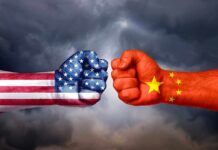
The bustling Huaqiangbei electronics market in Shenzhen is facing a crisis as U.S. tariffs on Chinese chips disrupt the industry, causing a ripple effect across the e-commerce sector.
Key Insights
- Huaqiangbei market sees reduced activity and declining chip orders due to U.S. tariffs.
- Prices for U.S.-sourced chips such as Intel and AMD have risen by 10 to 40 percent.
- Increased tariffs threaten China’s fast fashion and micro-shipment retailers.
- Chinese producers may adapt to tariffs with potential government support.
- E-commerce platforms face instability as tariffs impede access to U.S. consumers.
Tariffs Hit Huaqiangbei Market Hard
Huaqiangbei, the epicenter for China’s chip industry, is reeling from the recent U.S. tariffs. Traders are reporting a drastic downturn in activity, with some distributors witnessing a near halt in operations due to sharp price hikes. For instance, a typical increase in prices for CPUs from Intel or AMD ranges from 10 to 40 percent. A distributor emphasized, “We’ve had almost no orders in recent days due to the price increase.”
While shoppers still frequent the streets of Huaqiangbei, indoor stalls tell a different story with empty aisles and silent cash registers. This market, largely dependent on U.S. chip imports for its offerings to domestic buyers, finds itself in a precarious position amid the ongoing trade war.
E-Commerce at Risk
China’s e-commerce industry is facing significant challenges as a 145 percent tariff on Chinese goods threatens its business with American consumers. The e-commerce sector, which thrives on micro-shipments, is heavily impacted. Retailers such as Shein and Temu, which rely on the de minimis loophole for sending small packages to U.S. customers, face serious upheaval. Projections suggest the new 120 percent tax, effective from May 2, could disrupt business models critically.
E-commerce giants are exploring alternative markets, recognizing the unique purchasing power the American market holds. Despite the uncertainty, some analysts hint that China’s competitive production costs might allow it to weather the tariff storm, especially if government subsidies come into play. However, others emphasize the unpredictability surrounding the market’s future.
A tiny company just made a $2,000 smartphone almost entirely in the US. They solder chips by hand in California, build their own boards, even write the OS.
it's slow, expensive, and kinda clunky.
but it shows this: if China tariffs stick, America can rebuild tech manufacturing.… pic.twitter.com/ndhQqGzRmd
— Shashank | 𝔽rAI (@0xshai) April 11, 2025
Possibilities for Adaptation
The escalating trade tensions have left Chinese producers considering potential adaptations. The prospect of government interventions and the establishment of new digital marketplaces are being discussed as viable countermeasures to the American tariffs. With American import tariffs reaching a cumulative rate of about 156 percent, and China countering with tariffs of its own, the stakes have never been higher for market stakeholders navigating this precarious landscape.
For those keeping a close watch on trade and economic trends, these developments hold considerable ramifications and present an ongoing concern as market players strategize for the foreseeable future.
Sources:
- Hit by Trump’s tariffs, China’s chip traders decry ‘no point in working’ as orders tank
- Trump tariffs live updates: Trump touts trade talk progress, says ‘going to make a deal’ with China
- China Chip Traders Grumble that Trump Tariffs Sent Orders Plummeting

























